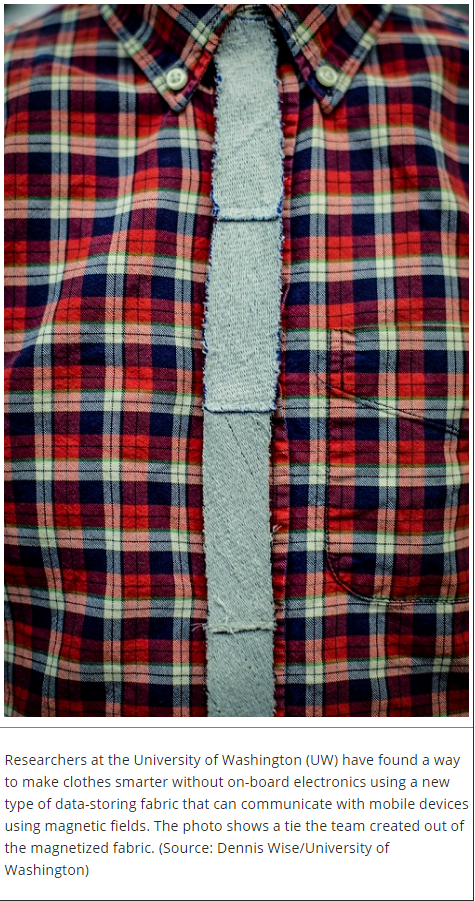Smart Fabric Uses Magnetic Fields to Store, Transmit Data Without Electronics
Researchers at the University of Washington have found a way to make clothes smarter without on-board electronics using a new type of data-storing fabric that leverages technology already found in smartphones.
One limitation to wearable technology is the need for electronics and wiring that make so-called “smart” clothing not so comfortable to wear.
Researchers at the University of Washington (UW) have found a way to make clothes smarter without on-board electronics using a new type of data-storing fabric that leverages technology already found in smartphones.
The fabric eliminates one of the key reasons wearable technology and smart clothing hasn’t quite caught on yet, said Justin Chan, a doctoral student at UW who worked on the project.
“One thing preventing the adoption of smart fabrics is the fact that they typically require an electronic chip or microcontroller to be attached to your clothing,” he explained to Design News. “This can be cumbersome as they require charging. By taking an electronic-free approach, we can create smart fabrics that are highly durable and waterproof against rainwater and laundry cycles.”

The fabric and accessories created from the fabric can store data--such as security codes and identification tags--without sensors or electronics by using previously unexplored magnetic properties of off-the-shelf conductive thread, he said. An instrument embedded in existing smartphones that enables navigation applications can read the data.
“Conductive threads are typically used in smart-fabric designs as a wire to carry electricity from one point to another,” Chan explained. “What we discovered was that we could magnetize these threads using a magnet like a fridge magnet. We could then sense the thread's presence or absence using a magnetometer, a sensor used to measure magnetic fields.”
Smartphones already all have magnetometers because they are used in navigation apps like GPS to determine direction, he said. Researchers leveraged this existing technology to sense whether conductive thread is nearby.
“We can encode data onto these magnetized fabrics in the same way that data is stored on the magnetic hard drive on your computer,” Chan explained.
Using conventional sewing machines, the team embroidered these conductive threads into regular textiles, and then polarized each cell with a north or south pole to embed a 0 or 1, he said. Specifically, they took a thin 5-millimeter strip of conductive fabric, divided it up into 2-centimeter long cells, and embedded a bit onto each cell, Chan explained.
“We can easily encode data like serial numbers, or 2D images with a unique pattern like miniature QR codes,” he said.
The UW team created prototype fashion accessories out of the magnetized fabric, including a tie, belt, necklace, and wristband. In one instance to test the material, they stored the passcode to an electronic door lock on a patch of conductive fabric sewn to a shirt cuff, then unlocked the door by waving the cuff in front of an array of magnetometers.
Chan said the team envisions two key applications for their work. One is for invisible tags to be sewn into clothing sold at department stores to help pre
by: Elizabeth Montalbano Electronics & Test November 13, 2017
Are you ready to upgrade for your clothing brand?
Welcome to contact us by sending an e-mail to sales@eleheat.com.cn
Eleheat will provide you professional One-Stop Solution for Smart Clothing.
Make you Clothing more Functional and Comfortable.
